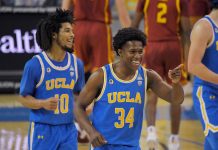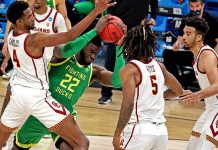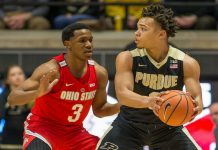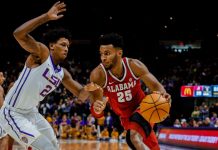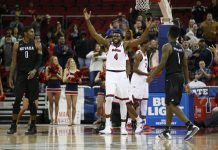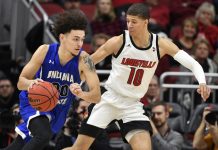Message to hoops fans: This story could make you look brilliant.
A computer science professor at University of Illinois has created a formula that predicts NCAA tournament upsets at double the success rate of someone picking at random – including, but not limited to, those who throw darts at the bracket, or pick based on their favorite color, the most ferocious mascot or the number of vowels in the coach’s last name.
This year’s upset picks both come out of the South region. They are No. 13 Buffalo over No. 4 Arizona and No. 14 Wright State over No. 3 Tennessee.
But before betting the mortgage, read on:
The computer scientist who spearheads this project , Sheldon Jacobson, says the computer models only analyze potential upsets by 13, 14 and 15 seeds. A 16 seed has never beaten a 1; anything involving 11s or 12s produce ”too much noise,” Jacobson says, meaning the relative closeness of the underdogs with their fifth- and sixth-seeded opponents interferes with the statistical model he uses to predict the upsets.
Jacobson and fellow scientists pared down 115 publicly available metrics for every team in college basketball to 15 that have served as the best predictors of upsets in years past.
Some examples include effective possession ratio – essentially the number of points a team scores per possession – along with average scoring margin and opponent’s 3-point shooting percentage.
Now for the science: The framework of these formulas is called ”balance optimization subset selection” (BOSS), which is an artificial-intelligence algorithm (Google that if so inclined). The National Science Foundation initially funded Jacobson for a project that used artificial intelligence to explore societal issues, such as whether government-sponsored programs to enhance job skills ultimately lead to higher incomes for workers.
After the funding ran out, Jacobson sought uses for his creation that could REALLY help people.
March Madness generates more than $10 billion a year in wagering, much of which comes when players chip in $10 or $20 and fill out brackets for their office pools and collect points based on the number of correct picks.
Picking the eventual champion – No. 1 seeds Villanova and Virginia started at 5-1 odds to win it all, with No. 2 Duke at 6-1 – always helps. But sometimes the real difference makers are the correct upset picks in the early rounds. That’s when the Buffalos and Wright States of the world beat Goliath and briefly restore faith in the gumdrops-and-lollipops notion that anything really is possible.
It’s not, Jacobson assures us.
Still, his website, bracketodds.cs.illinois.edu , gets thousands of hits a day this time of year. Among his other basketball-related projects are predicting which teams will make the tournament and where they’ll be seeded. The computer didn’t do so well this year – it had Louisville and USC comfortably in – in large part because, as Jacobson says, the selection committee ”keeps changing the rules.”
”You had a team like Arizona State that got in despite some horrible home losses to mediocre Pac-12 teams, and then you have Louisville, which is the kind of team that typically gets in but didn’t,” Jacobson said.
But that was then.
Once the brackets were revealed, Jacobson set the computer’s focus toward picking these upsets. Its track record since 2003 is hardly perfect, but still probably better than yours.
Using BOSS, the computer picks the two most likely upsets each year. Last season, not a single 13, 14 or 15 advanced, so it got 0 percent. Two seasons ago, there were three such upsets – Iona and Buffalo – but the computer didn’t pick either of them.
But in 2015, BOSS picked Georgia State and UAB and went 2 for 2.
And since 2003, 10 of its 26 selected games have resulted in upsets. That’s 38.4 percent, or double the expected number of correct selections a person would get by using a ”weighted random selection method.” In other words, double what you’d get by picking slips out of a hat, or choosing a team because you like the fight song.
For those placing faith in his science, Jacobson warns of the large gulf between predicting the future and forecasting what could happen.
`’Nobody predicts the weather,” he says. ”They forecast it using chances and odds.”
Similarly, he says, ”artificial intelligence looks at some outcomes that the human eye can’t catch. The models we use give some indication of what the future may look like.”
A few other caveats:
Jacobson freely admits he does not gamble on basketball or anything else.
Nor does he fill out a bracket.
—
More AP college basketball: http://collegebasketball.ap.org and http://www.twitter.com/AP-Top25
25% Bonus via Western Union


